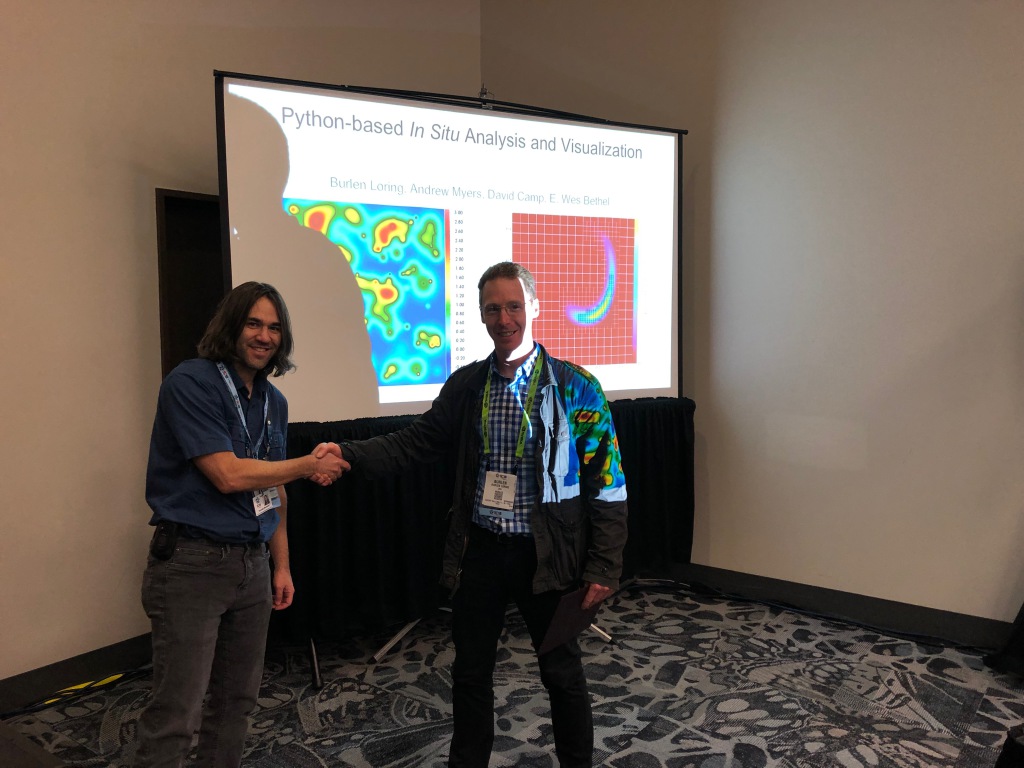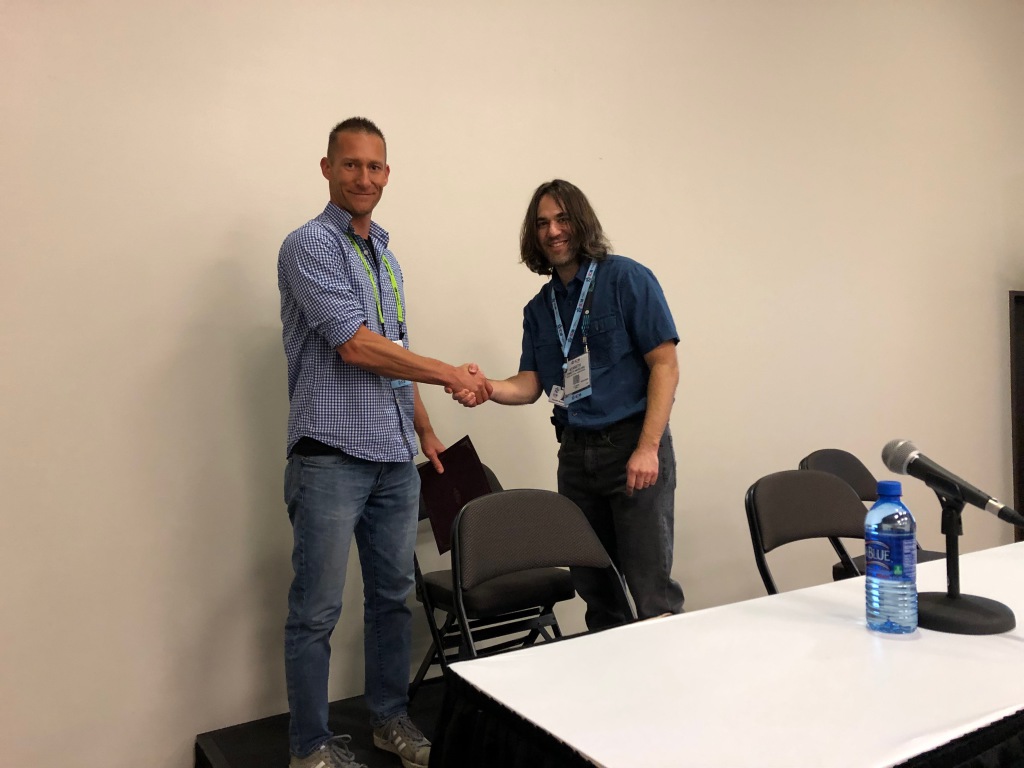ISAV 2018: In Situ Infrastructures for Enabling Extreme-scale Analysis and Visualization
Monday 12 Nov 2018, 9am-5:30pm
Location: D168
More information: https://sc18.supercomputing.org/presentation/?id=wksp101&sess=sess140
ISAV 2018 Proceedings at ACM:
https://dl.acm.org/citation.cfm?id=3281464, PDFs of papers accessible from the “table of contents” tab.
Workshop Theme
The considerable interest in the HPC community regarding in situ analysis and visualization is due to several factors. First is an I/O cost savings, where data is analyzed/visualized while being generated, without first storing to a file system. Second is the potential for increased accuracy, where fine temporal sampling of transient analysis might expose some complex behavior missed in coarse temporal sampling. Third is the ability to use all available resources, CPUs and accelerators, in the computation of analysis products.
The workshop brings together researchers, developers and practitioners from industry, academia, and government laboratories developing, applying, and deploying in situ methods in extreme-scale, high performance computing. The goal is to present research findings, lessons learned, and insights related to developing and applying in situ methods and infrastructure across a range of science and engineering applications in HPC environments; to discuss topics like opportunities presented by new architectures, existing infrastructure needs, requirements, and gaps, and experiences to foster and enable in situ analysis and visualization; to serve as a “center of gravity” for researchers, practitioners, and users/consumers of in situ methods and infrastructure in the HPC space.
Program (Location: Room D168)
| Session 1: Opening (session chair: Matthew Wolf, Oakridge National Laboratory) | |
| 09:00 - 09:05 | Opening Remarks |
| 09:05 - 10:00 | Keynote: Perspectives on In Situ by Dr. Laura Biven, Senior Science and Technology Advisor, U.S. Department of Energy |
| 10:00 - 10:30 | Morning Refreshment Break |
| Session 2: Coupling and Workflows (session chair: Ken Moreland, Sandia National Laboratory) | |
| 10:30 - 12:10 | Short Papers Session 1 (20 minute talks and 5 minutes for questions per talk)
|
| 12:10 - 12:30 | Lightning Round Talks (5 minute talks and questions at end of session)
|
| 12:30 - 14:00 | Lunch Break (Continued Discussion) |
| Session 3: In Situ Systems (session chair: Earl Duque, Intelligent Light) | |
| 14:00 - 14:50 | Short Papers Session 2 (20 minute talks and 5 minutes for questions per talk)
|
| 14:50 - 15:00 | Best Paper Awards |
| 15:00 - 15:30 | Afternoon Refreshment Break |
| Session 4 (session chair: Earl Duque, Intelligent Light) | |
| 15:30 - 16:25 | Invited presentation: Data Science Meets CFD, Mr. Steve M. Legensky, Founder and CTO, Intelligent Light |
| Session 5 (session chair and moderator: Matthew Wolf, Oak Ridge National Laboratory) | |
| 16:25 - 17:20 | UnPanel on the State of the In Situ Community |
| 17:20 - 17:30 | Discussion, Karaoke, Wrap Up |
Best Paper Awards
Honorable Mentions
- PaDaWAn: a Python Infrastructure for Loosely Coupled In Situ Workflows, Julien Capul, Sebastien Morais, Jacques-Bernard Lekien (Honorable Mention)
- Python-based In Situ Analysis and Visualization, Burlen Loring, Andrew Myers, David Camp, E. Wes Bethe (Honorable Mention)

Best Paper
- A Flexible System For In Situ Triggers, Matthew Larsen, Amy Woods, Nicole Marsaglia, Ayan Biswas, Soumya Dutta, Cyrus Harrison, Hank Childs (Best Paper)

Participation/Call for Papers
We invite two types of submissions to ISAV 2018: (1) short, 4-page papers that present research results, that identify opportunities or challenges, and that present case studies/best practices for in situ methods/infrastructure in the areas of data management, analysis and visualization; (2) lightning presentation submission, consisting of a 1- or 2-page submission, for a brief oral presentation at the workshop. Short papers will appear in the workshop proceedings and will be invited to give an oral presentation of 15 to 20 minutes; lightning round submissions that are invited to present at the workshop will have author names and titles included as part of the proceedings. Submissions of both types are welcome that fall within one or more areas of interest. Areas of interest for ISAV, include, but are not limited to:
- In situ infrastructures: Current Systems: production quality, research prototypes; Opportunities; Gaps
- System resources, hardware, and emerging architectures: Enabling Hardware; Hardware and architectures that provide opportunities for In situ processing, such as burst buffers, staging computations on I/O nodes, sharing cores within a node for both simulation and in situ processing.
- Methods/algorithms/applications/Case studies: Best practices; Analysis: feature detection, statistical methods, temporal methods, geometric methods; Visualization: information visualization, scientific visualization, time-varying methods; Data reduction/compression; Examples/case studies of solving a specific science challenge with in situ methods/infrastructure.
- Simulation: Integration, data modeling, software-engineering; Resilience: error detection, fault recovery; Workflows for supporting complex in situ processing pipelines
- Requirements: Preserve important elements; Significantly reduce the data size; Flexibility for postprocessing exploration
Review Process
All submissions will undergo a peer-review process consisting of three reviews by experts in the field, and evaluated according to relevance to the workshop theme, technical soundness, creativity, originality, and impactfulness of method/results. Lightning round submissions will be evaluated primarily for relevance to the workshop.
Submission Process
Authors are invited to submit papers of at most 4 pages in PDF format, excluding references, and lightning presentations of at most 2 pages in PDF format, excluding references. Papers must be submitted in PDF format (readable by Adobe Acrobat Reader 5.0 and higher) and formatted for 8.5” x 11” (U.S. Letter). Please use the sigconf configuration in the new combined LaTeX template from ACM available at http://www.acm.org/publications/article-templates/proceedings-template.html
We believe that reproducible science is essential, and that SC should be a leader in this effort. As a consequence ISAV 2018 participates in the SC reproducibility initiative and encourages submitters to include an appendix with reproducibility information. While we will not disqualify a paper based on information provided or not provided in this appendix, nor if the appendix is not available, the availability and quality of an appendix will be used in ranking a paper. For more information, see the ISAV 2018 reproducibility FAQ.
Papers must be self-contained and provide the technical substance required for the program committee to evaluate their contributions. Submitted papers must be original work that has not appeared in and is not under consideration for another conference or a journal. See the ACM Prior Publication Policy for more details. Papers can be submitted at https://submissions.supercomputing.org.
Publication in proceedings, presentation at the workshop
All paper submissions that receive favorable reviews will be included as part of the workshop proceedings, which will be published by the ACM, and will appear in the ACM Digital Library as part of the International Conference Proceedings Series. Lightning round submissions will not be included as part of the proceedings. Subject to the constraints of workshop length, some subset of the accepted publications will be invited to give a brief oral presentation at the workshop. The exact number of such presentations and their length will be determined after the review process has been completed.
Timeline/Important Dates
| 10 August 2018 | Abstract submission deadline |
| Paper submission deadline | |
| 21 September 2018 | Author notification |
| 05 October 2018 | Camera ready copy due |
| 17 October 2018 | Final program posted to ISAV web page |
| 12 November 2018 | ISAV 2018 workshop at SC18 |
Committees and Chairs
- General Chair: Matthew Wolf, Oak Ridge National Laboratory, USA
- Program Chair: Kenneth Moreland, Sandia National Laboratories, USA
- Program Co-Chair: E. Wes Bethel, Lawrence Berkeley National Laboratory, USA
- Publicity Chair: Earl Duque, Intelligent Light
- Publication Chair: Nicola Ferrier, Argonne National Laboratory, USA
- Publication Co-Chair: Silvio Rizzi, Argonne National Laboratory, USA
- Early Career Program Committee Chair: E. Wes Bethel, Lawrence Berkeley National Laboratory, USA
- At-large Chair: Patrick O’Leary, Kitware, Inc., USA
Organizing Committee
- E. Wes Bethel, Lawrence Berkeley National Laboratory, USA
- Earl Duque, Intelligent Light
- Nicola Ferrier, Argonne National Laboratory, USA
- Patrick O’Leary, Kitware, Inc., USA
- Gunther H. Weber, Lawrence Berkeley National Laboratory, USA
- Matthew Wolf, Oak Ridge National Laboratory, USA
Program Committee
- Ilkay Altintas, San Diego Supercomputer Center, USA
- Rushil Anirudh, Lawrence Livermore National Laboratory, USA
- Hank Childs, University of Oregon, USA
- Philip Davis, Rutgers University, USA
- Matthieu Dorier, Argonne National Laboratory, USA
- Tom Fogal, NVIDIA Corporation, USA
- Steffen Frey, University of Stuttgart, Germany
- Christoph Garth, University of Kaiserslautern, Germany
- Wesley Griffin, National Institute of Standards and Technology, USA
- Pascal Grosset, Los Alamos National Laboratory, USA
- Joseph A. Insley, Argonne National Laboratory, Northern Illinois University, USA
- David Kao, NASA Ames Research Center, USA
- Matthew Larsen, Lawrence Livermore National Laboratory, USA
- Samuel Li, National Center for Atmospheric Research, USA
- Burlen Loring, Lawrence Berkeley National Laboratory, USA
- Preeti Malakar, Argonne National Laboratory, USA
- Paul A. Navratil, University of Texas – Austin, USA
- Kenji Ono, Kyushu University, RIKEN, Japan
- David Pugmire, Oak Ridge National Laboratory, USA
- Bruno Raffin, INRIA, France
- Silvio Rizzi, Argonne National Laboratory, USA
- Thomas Theussl, King Abdullah University of Science and Technology, Saudi Arabia
- David Thompson, Kitware, Inc., USA
- Tom Vierjahn, Westphalian University of Applied Sciences, Germany
- Brad Whitlock, Intelligent Light, USA
- Sean Ziegeler, US Department of Defense HPC Modernization Program, Engility Corporation, USA
Early Career Program Committee
- Roba Binyahib, University of Oregon, USA
- Jai Dayal, Intel Corporation, USA
- Colleen Heinemann, Lawrence Berkeley National Laboratory, University of Illinois, USA
- Mark Kim, Oak Ridge National Laboratory, USA
- James Kress, Oak Ridge National Laboratory, University of Oregon, USA
- Shusen Liu, Lawrence Livermore National Laboratory, USA
- Jonas Lukasczyk, University of Kaiserslautern, Germany
- Jesus Pulido, University of California, Davis; Los Alamos National Laboratory, USA
- Randall Reese, Idaho National Laboratory, USA
- Sudhanshu Sane, University of Oregon, USA
Best Paper Award Committee
- Philip Davis, Rutgers University, USA
- Tom Fogal, NVIDIA Corporation, USA
- Thomas Theussl, King Abdullah University of Science and Technology, Saudi Arabia